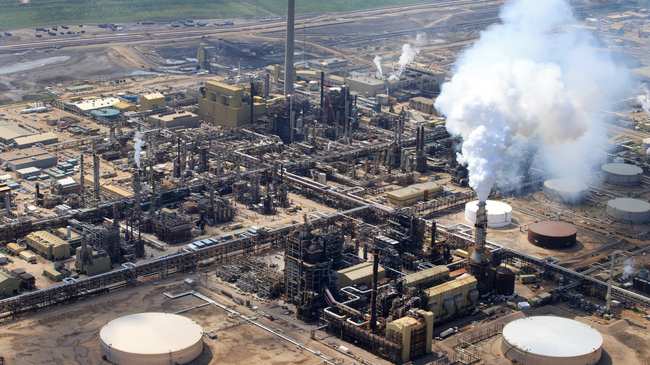Canadian Oil Companies Might Be Emitting Way More Than Reported
A new study suggests oil sands carbon emissions could be as much as 64 percent higher.

Photo by Larry MacDougal / The Canadian Press
Companies in Canada’s oil sands could be inadvertently painting a sunnier picture of their greenhouse gas emissions than is actually true, according to a new study that could have major implications for Canada’s Paris Agreement commitments.
The peer-reviewed paper in the journal Nature Communications found these companies could be underreporting their emissions by as much as 64 percent, according to measurements gathered from aircraft flying over the oil sands in August and September, 2013.
“The results indicate that CO2 emission intensities for [oil sands] facilities are 13 to 123 percent larger than those estimated using publicly available data. This leads to 64 percent higher annual GHG emissions from surface mining operations, and 30 percent higher overall [oil sands] GHG emissions (17 megatons) compared to that reported by the industry,” the study says.
It’s not that companies are lying about their emissions, the paper says; it’s that the methodology they’re using could be giving inaccurate results. And the authors say the findings indicate that other industrial sources of GHGs could also be reporting inaccurate numbers.
The global energy industry alone makes up about 35 percent of human-caused emissions, and most of that is the upstream oil and gas sector, the paper states. The large contribution of the industry “underscores the need” for accurate reporting, the authors say.
The findings are a big deal because, as the authors point out, the Paris Agreement that Canada signed onto sets out a goal of limiting the increase in global temperature to less than 1.5 degrees Celsius. Figuring out where we can make those cuts relies on accurate emissions estimates and reporting. And under the Paris Agreement, Canada has to submit emissions data every year. The study suggests that data from the oil and gas industry “may be more uncertain than previously considered”—meaning the data we’re submitting could be inaccurate.
This is especially worrying for Canada, which a government study published April 1 found is warming at more than double the global rate. Much of that warming is locked-in, meaning we can’t stop it.
Already, the government study found, Canada’s glaciers and sea ice are thinning quickly, permafrost temperatures are increasing, there is a higher risk of water shortages in summer, and the number of heat waves is climbing along with risk of drought and fire weather. Flooding in cities is increasing, and sea level rise is threatening the east coast.
Under an ambitious scenario in which we rapidly decrease our emissions, Canada could cap its emissions to 2 degrees Celsius of warming above pre-industrial rates, the government study said. But if we continue with business as usual, Canada’s temperature would warm by 6 degrees Celsius.
No comments:
Post a Comment